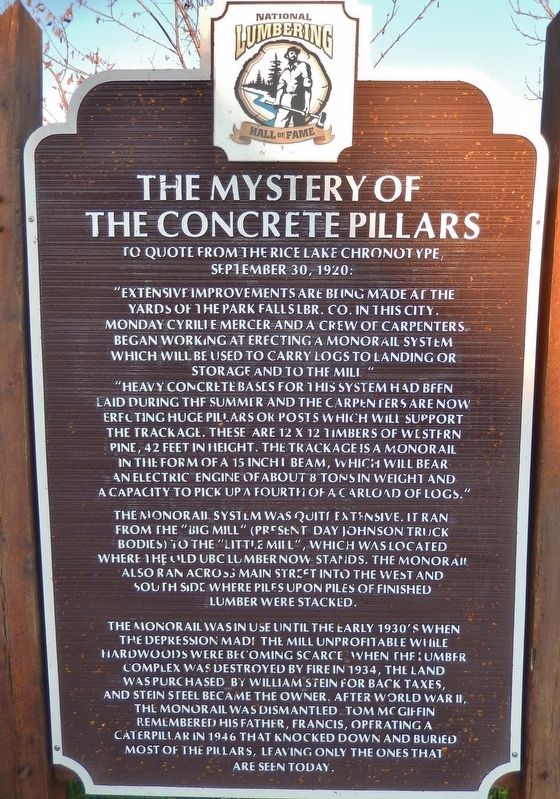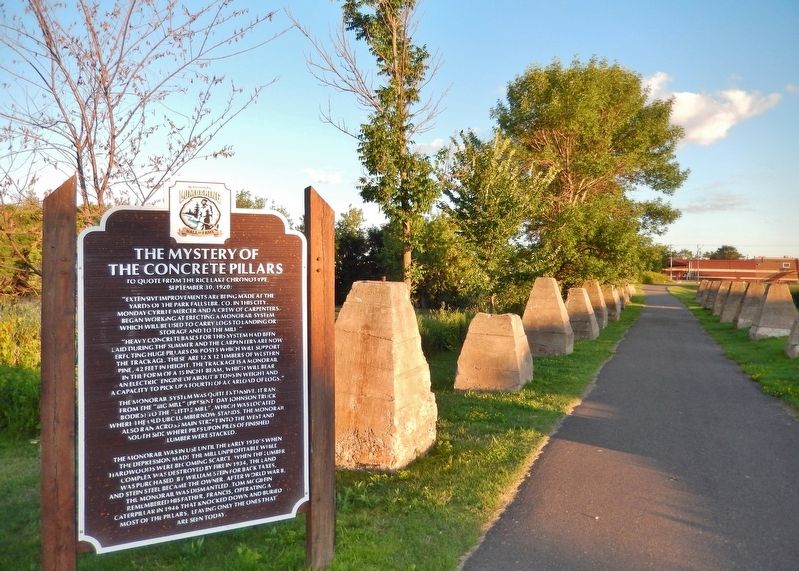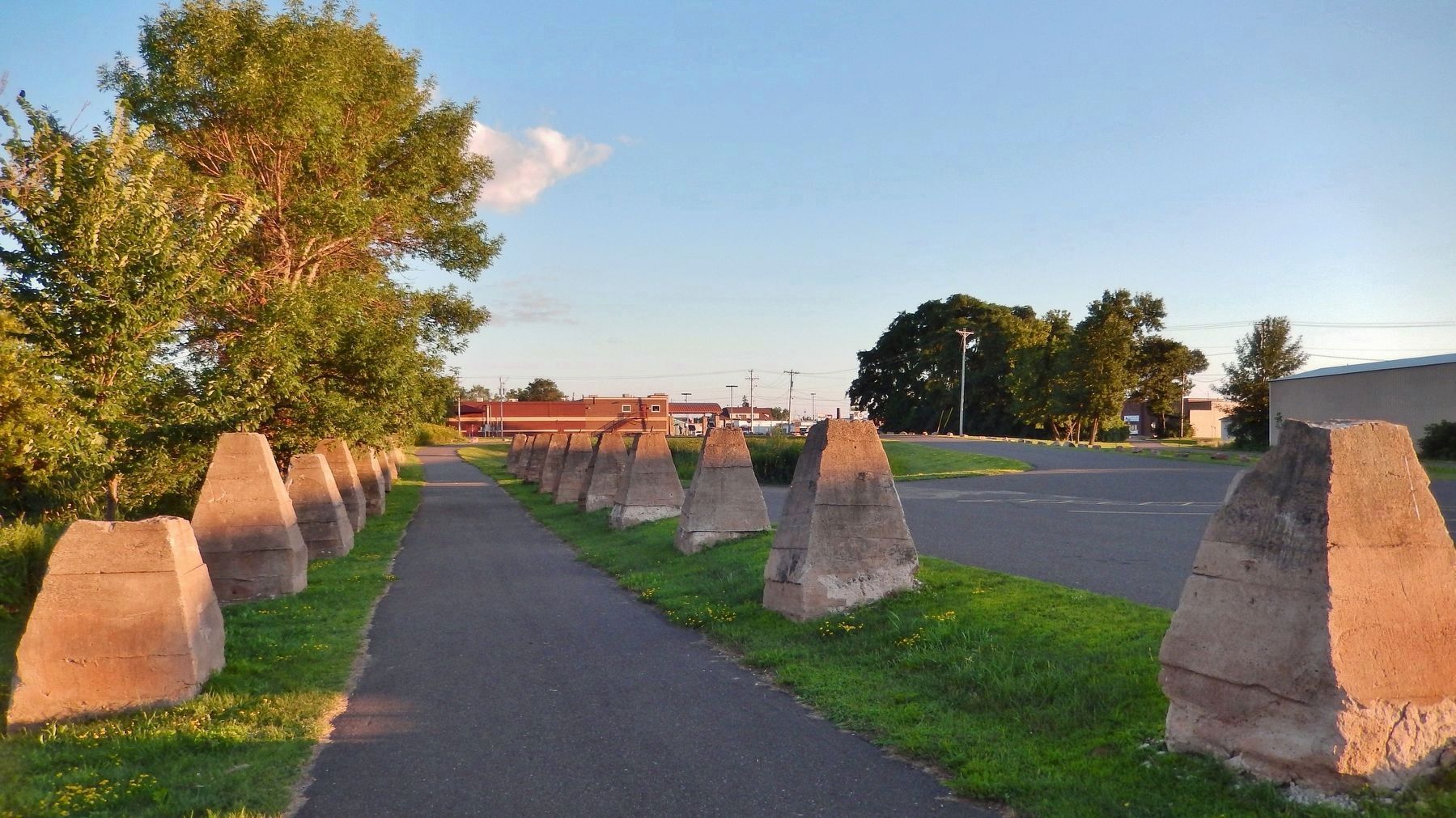Rice Lake in Barron County, Wisconsin — The American Midwest (Great Lakes)
The Mystery of the Concrete Pillars
”Extensive improvements are being made at the yards of the Park Falls Lbr. Co. in this city. Monday Cyrille Mercer and a crew of carpenters began working at erecting a monorail system which will be used to carry logs to landing or storage and to the mill.”
”Heavy concrete bases for this system had been laid during the summer and the carpenters are now erecting huge pillars or posts which will support the trackage. These are 12 X 12 timbers of western pine, 42 feet in height. The trackage is a monorail in the form of a 15 inch I beam, which will bear an electric engine of about 8 tons in weight and a capacity to pick up a fourth of a carload of logs.”
The monorail system was quite extensive. It ran from the “big mill” (present day Johnson Truck Bodies) to the “little mill,” which was located where the old UBC Lumber now stands. The monorail also ran across main street into the west and south side where piles upon piles of finished lumber were stacked.
The monorail was in use until the early 1930’s when the depression made the mill unprofitable while hardwoods were becoming scarce. When the lumber complex was destroyed by fire in 1934, the land was purchased by William Stein for back taxes, and Stein Steel became the owner. After World War II, the monorail was dismantled. Tom McGiffin remembered his father Francis operating a caterpillar in 1946 that knocked down and buried most of the pillars, leaving only the ones that are seen today.
Erected by National Lumbering Hall of Fame.
Topics. This historical marker is listed in these topic lists: Industry & Commerce • Man-Made Features • Railroads & Streetcars. A significant historical date for this entry is September 30, 1920.
Location. 45° 29.884′ N, 91° 43.9′ W. Marker is in Rice Lake, Wisconsin, in Barron County. Marker can be reached from Stein Street east of South Main Street (County Highway SS), on the right when traveling east. Marker and subject concrete pillars are located at the south end of the Eagle's Lookout Boat Launch parking lot at this address. Touch for map. Marker is at or near this postal address: 100 Stein Street, Rice Lake WI 54868, United States of America. Touch for directions.
Other nearby markers. At least 5 other markers are within 6 miles of this marker, measured as the crow flies. Rice Lake, a City Built of Lumber (within shouting distance of this marker); Logging and Lumbering in the Rice Lake Area (within shouting distance of this marker); Lentz Steam Engine (about 700 feet away, measured in a direct line); Our Lady of Lourdes Catholic Church (approx. 4½ miles away); The Tuscobia Trail (approx. 5.3 miles away).
Related markers.
Click here for a list of markers that are related to this marker. Rice Lake, Wisconsin Lumbering History
Also see . . .
1. Rice Lake, Wisconsin - A Brief History. The town of Rice Lake had its first beginnings around 1864-1867. During this time, John Knapp purchased acres of forest land that became part of the property owned by the largest lumber company in the world; Knapp, Stout & Co. Prior to the lumber company, the land was inhabited by the Chippewa and other American Indian groups. They lived on the land through trapping and gathering wild rice in the lakes and bogs. In 1870, Knapp, Stout & Co. dammed the Red Cedar River to creat a lake for use as a holding pond. This subsequently flooded the region's wild rice beds. In 1870, 1875 and 1884 the company platted the village and left a 100-foot wide thoroughfare that later became Rice Lake's business district. By 1880, the firm owned 115,000 acres and produced 90 million feet of cut lumber annually. (Submitted on October 19, 2018, by Cosmos Mariner of Cape Canaveral, Florida.)
2. Forestry Museum & Lumbering Hall of Fame. Stone pillars are all that remain of the old monorail system that helped transport lumber throughout the city until it was shut down in the 1930s. (Submitted on December 4, 2020, by Cosmos Mariner of Cape Canaveral, Florida.)
Credits. This page was last revised on November 22, 2022. It was originally submitted on July 21, 2018, by Cosmos Mariner of Cape Canaveral, Florida. This page has been viewed 910 times since then and 65 times this year. Photos: 1, 2, 3. submitted on July 21, 2018, by Cosmos Mariner of Cape Canaveral, Florida. • Andrew Ruppenstein was the editor who published this page.


